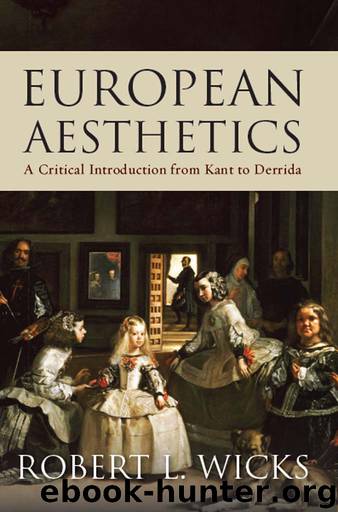European Aesthetics: A Critical Introduction from Kant to Derrida by Robert L. Wicks

Author:Robert L. Wicks [Wicks, Robert L.]
Format: epub
ISBN: 9781780740775
Publisher: Perseus Books, LLC
3. CONCLUSION AND CRITICISM
Invoking the Marxist idea that a community’s social consciousness necessarily echoes changes in the society’s economic structure, Benjamin observes that in the age of mechanical reproduction, we will inevitably begin to perceive and interpret our surroundings in terms of duplications, reiterations, and reinstantiations. Simply put, if our lifestyle locates us in front of a computer screen or television set for an extended period of time, it will dispose us to interpret off-screen reality as a universal computer screen or television presentation.
Benjamin consequently anticipates that autographic arts will lose their importance as mechanical reproduction increases its cultural presence and allographic arts take their place. We can expect future generations to live in an age where music, the motion picture, photography (and now, digital photography), and the printed page (and now, webpages) prevail as the socially leading art forms. We can include mass-produced architecture as well, for example, buildings where the designs are minor variations on a basic plan. Individual paintings, sculptures, and unique architectural works will accordingly fade from social importance, at least insofar as they are perceived as irreplaceable, non-reproducible works. This is one way to understand Benjamin’s remark that in the age of mechanical reproduction, the artwork’s aura will erode, dissolve, or disappear. It will vanish supposedly because the kinds of art forms that naturally have an aura will either fade from social prominence or will no longer be practiced. We can call this a genuine sense of aura-dissolution, since the allographic arts that will dominate the art scene and general culture will indeed have no original instances.
As noted earlier, sometimes Benjamin speaks of aura-dissolution in a second sense, where although a work of art has an original instance and embodies the “original vs. copy” mode of being, the social disposition will be to ignore that autographic mode of being, and instead interpret the work as if it had the allographic being of a photograph or film. Under these conditions, we would begin to believe that a copy of the Mona Lisa, assuming it were accurate enough, is just as good, or as aesthetically serviceable as the original. If the original were lost in a fire, it would make no significant aesthetic difference to such a technology-saturated mentality, for it would compare to losing a copy of a book in a fire, assuming hundreds or thousands of other copies were to remain.
Along the same interpretive lines, a photograph of a person would be perceived as substitutable for the real person in many relevant ways. This is not a strange idea. Consider how we can pass someone on a crowded city street momentarily for the first and possibly last time in our lives, and apprehend nothing more than their passing profile. Consider how much more information we would obtain about the person if we had photographed him or her when walking by, and later studied the photograph, with its details far in excess of whatever we might have perceived in the originally passing moment. In such a
Download
This site does not store any files on its server. We only index and link to content provided by other sites. Please contact the content providers to delete copyright contents if any and email us, we'll remove relevant links or contents immediately.
The remains of the day by Kazuo Ishiguro(7550)
Tools of Titans by Timothy Ferriss(6945)
The Black Swan by Nassim Nicholas Taleb(6190)
Inner Engineering: A Yogi's Guide to Joy by Sadhguru(5894)
Giovanni's Room by James Baldwin(5877)
The Way of Zen by Alan W. Watts(5798)
The Six Wives Of Henry VIII (WOMEN IN HISTORY) by Fraser Antonia(4789)
The Power of Now: A Guide to Spiritual Enlightenment by Eckhart Tolle(4753)
Astrophysics for People in a Hurry by Neil DeGrasse Tyson(4619)
Asking the Right Questions: A Guide to Critical Thinking by M. Neil Browne & Stuart M. Keeley(4574)
12 Rules for Life by Jordan B. Peterson(3733)
The Ethical Slut by Janet W. Hardy(3502)
Skin in the Game by Nassim Nicholas Taleb(3459)
Housekeeping by Marilynne Robinson(3401)
The Art of Happiness by The Dalai Lama(3382)
Double Down (Diary of a Wimpy Kid Book 11) by Jeff Kinney(3272)
Skin in the Game: Hidden Asymmetries in Daily Life by Nassim Nicholas Taleb(3264)
Walking by Henry David Thoreau(3234)
12 Rules for Life: An Antidote to Chaos by Jordan B. Peterson(3200)
